
Fractures Page Menu: 1 2 3 4 5 6 7 8 9 10 11 12 Next>>
Fracture Treatment During the Golden Age of Piracy, Page 6
Maintaining the Bone's Position
The second step in curing fractures during the golden age of piracy was to maintain the position of the two parts of the fractured bone.
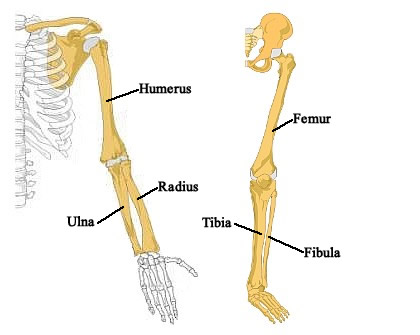
The Primary Bones of the Human Limbs Labeled
Left to itself, the body will repair broken bones if they are not moved. Once adjusted so that the ends were properly aligned, they had to be left that way so that the healing process could proceed.
The period surgeons understood that the bones needed to be kept in place so that a callus could form between the two broken ends. To make this happen, a number of methods were used. The most obvious was bandaging the part. This restricted movement and allowed the wound to heal when the fracture was complex. Once the fracture began to heal, the dressings were adjust to promote the healing process.
Various mechanical devices could also be used to keep the fracture aligned. Splints preserved the alignment of the bones and further restricted movement. A sling was sometimes employed to keep the broken bones in an arm - the upper femur and lower tibia and fibula - stationary. Crutches were used to keep the weight off of broken femurs, tibias and/or fibulas while they healed.
Maintaining the Bone's Position: Generating Callus
Many of the period surgeons understood that it was necessary to maintain the bone's position so that a callus could form. Military surgeon Richard Wiseman explained that the surgeon must allow "Callum ganerare, to make Callus; which is to be endeavoured after

Bone Composition Showing Woven Bone Fibers
the fear of Inflammation is over"1.
Today we recognize that the regeneration of bone is more complex than just the formation of a callus. (For those curious about the mechanical details of this process as we understand it now, check out this web page.)
Even if they didn't know exactly how bones repaired themselves, period surgeons did grasp the important aspects of the process, knowing that keeping the limb immobile to encourage healing was key. Ambroise Paré explained that to form a callus, the patient had to be given "rest and lying of the part in its proper figure and site [which it was] accustomed [to when the patient was] in health, that so it may the longer remaine in the same place unstirred."2
Sea surgeon John Woodall warned that "great care must be had, that the legge must be kept steddy [after being set], for disquiet therein will bring apostumation, and mortification, and death also"3. The essence of this concept, still in use today, goes all the way back to Hippocrates.
1 Richard Wiseman, Of Wounds, Severall Chirurgicall Treatises, p. 470; 2 Ambroise Paré, The Apologie and Treatise of Ambroise Paré, p. 170; 3 John Woodall, the surgions mate, p. 165; ;
Maintaining the Bone's Position: Bandaging
"The second intention of curing Fractures is, that the Parts be brought together may so be preserved: And that is performed by Bandage, which ought to be so made, as not only to keep the Parts so joined together, but to defend them from Inflammation." (Richard Wiseman, Of Wounds, Severall Chirurgicall Treatises, p. 467)
Once the fracture was reduced - meaning it had been
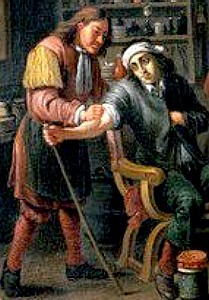
Artist: David Teniers II
Barber Surgeon Treating An Arm
extended and set into its proper position - the part was bandaged. Effective bandaging was an important part of treating a fracture because the dressings held everything in place so that the body could repair the breach.
Bandages were also was key to treating complex fractures, keeping the accompanying wound covered while also allowing the surgeon access to it when necessary. Ambroise Paré advised surgeons "it is expedient then only to dresse the part, when it is needful, & with those things that are requisite, shunning, as much as may be, inflammation and paine. That figure is thought the best ...which containes the muscles in their site, which is without paine; so that the Patient may long endure it without labour or trouble."1
The elements of period bandages have been covered in extensive detail in the Dressings article, which is worth reading to understand some of the more intricate details of bandaging during the golden age of piracy. We will focus here on the bandages only as they relate to treating fractures.
Period surgical authors discussed many aspects of bandaging a fracture including the size and texture of the bandage, how the bandages should be medicated to repel bodily humors and keep the wounded part from infection, how tight the bandage should be and how smoothly the bandages should be applied. There was also a great deal of discussion about the way the dressings should be applied to best support the fracture and permit access to the wound.
3 Ambroise Paré, The Apologie and Treatise of Ambroise Paré, p.170
Bandage Size and Texture
Hippocrates advised that when the surgeon dressed a compound fracture, "cloths for bandages and the other things should be torn broader than in cases in which there is no wound, and the first turn of the bandage should be a good deal broader than the wound."1 He further warned that a narrower cloth "binds the wound like a girdle, which is not proper"2.
Following Hippcrates' advice for binding fractures, military surgeon William Clowes noted, "I did take linen cloths so large as did not only comprehend the fracture but also
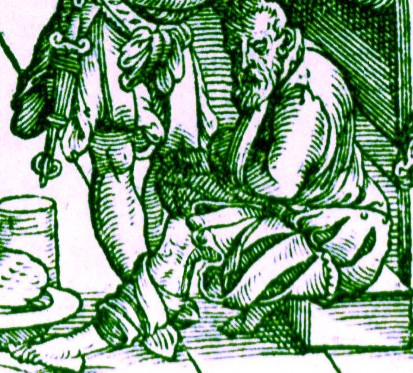
A Leg Bandage Showing Large Rollers, From Opus Chyrurgicum,
by Artzney Buch, p. 10 (1565)
covered over some of the whole and sound parts"3. He specifically details that he used roller bandages "two yards long and four fingers broad"4.
Sea surgeon John Woodall takes a slightly different approach, explaining
I use no rowlers [roller bandages] at all, but clowts [clouts – pieces of fabric], splints armed [covered with cloth to protect the body from them] and tape [thin pieces of fabric], my reason is, it is a great disease and disquiet to my patient, yea though I have two assistants to holde the member, to come so oft about the member as to rowle [roll] it, and endangereth much the disjointing of the boanes againe, and causeth paine.5
Some of the surgeons also discuss the texture of the fabric. Hippocrates explained, "The bandages should be of a soft consistence, and more especially so in such cases than in those not complicated with a wound."6 Clowes again agrees, suggesting the use of soft linen.7 Sea and military surgeon Richard Wiseman also hearkens to Hippocrates' writings, suggesting the use "of three Rowlers made of linen Cloath, not too course, lest thereby it should offend the fractured Member; nor yet too soft and fine, lest it break."8
1,2 Hippocrates, Hiipocratic Writings, Translated and Edited by Francis Adams, p. 84; 3,4 William Clowes, Selected Writings of William Clowes, p. 127; 5 John Woodall, the surgions mate, p. 161; 6 Hippocrates, ibid.; 7 Clowes, ibid.; 8 Richard Wiseman, Of Wounds, Severall Chirurgicall Treatises, p. 467
Bandage Medication
Fracture bandages were often dipped in medicine to protect the wounded part. A vinegar and water mixture was frequently suggested to help cleanse and resist infection. William Clowes advised dipping both regular
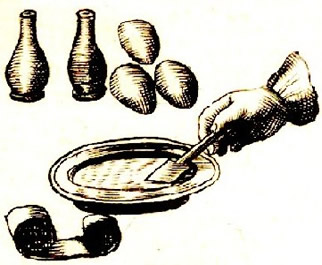
Mixing Bandage Coating Medicine, from L'Arcenal de
Chirurgerie
by Johannes Scultetus, p. 105 (1653)
and roller bandages in it before application to the fracture.1 Sea surgeon John Woodall also recommends bandages be wet with this combination.2 Fellow sea surgeon John Moyle advises a similar concoction for dressing simple fractures, explaining that "Your Bolster and Roulers should all be dipt in acetum Vini [wine vinegar] and alb. Ov. tund. [beaten egg whites]"3
Ambroise Paré suggests first soaking bandages in repelling (astringent) medicines, "to wit, applying of oyle of Roses with the whites of Egges, and the like."4 This is followed by resolving (inflammation reducing) medicines, if required. "It will be convenient, to moisten your rowlers [bandages] and boulsters [cloth pads] in oxycrate [vinegar and water] for this purpose, or else in Rose vinegar, if the Fracture be simple, or with red wine, or the like liquor warme (in Galens opinion) if a wound be joyned to a fracture"5.
German military
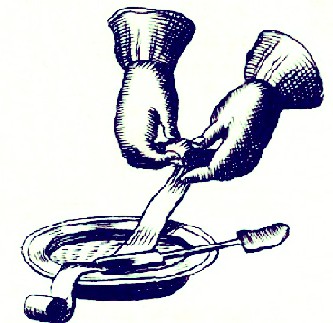
Soaking Bandage in Medicine, from L'Arcenal de
Chirurgerie
by Johannes Scultetus, p. 105 (1653)
surgeon Matthias Gottfried Purmann advises the use of vinegar diluted with water when dressing a fracture. He recommends a doubled linen cloth be "moistened in warm Wine Vinegar, and then wind it round with a Roller 3 Fingers broad, moisten’d also in Wine Vinegar, a hands breadth above and below the Fracture"6. Vinegar had wide support as a bandage defensive. However, Purmann warns surgeons that "the Wet Cloths will shrink when they dry and make the Bandage fit closer."7 So plan accordingly!
Paré adds some interesting things to his comments on medicating fracture bandages. He advises applying medicines more frequently in the summer so that as discharge is repelled and "the inflammation and paine are hindred."8 He also warns the surgeon to stop moistening bandages "when the symptomes are past, lest you retard the generating of a Callus"9. Moisture would actually have little impact on the healing of the fracture, but it could impact the healing of the wound in a compound fracture. Prolonged exposure to trapped moisture trapped could also irritate the skin when the fracture was simple.
1 William Clowes, Selected Writings of William Clowes, p. 127; 2 John Woodall, the surgions mate, p. 165; 3 John Moyle, The Sea Chirurgeon, p. 120; 4 Ambroise Paré, The Apologie and Treatise of Ambroise Paré, p. 169; 5 Paré, p. 169-70, 6,7 Matthias Gottfried Purmann, Churgia Curiosa, p. 213; 8,9 Paré, p. 170
Bandage Tightness
Bandages needed to be tight enough to hold the bones in place once they were adjusted, but loose enough so that the patient wasn't uncomfortable or, worse, in pain. Hippocrates gave detailed instructions on how to check bandage tightness.
And these are the signs that the patient has been well treated and properly bandaged: if you ask him if the arm feels tight, and he says it does, but moderately so, and especially about the fracture; and this reply he should make all along, if the bandage be properly applied. And these are the symptoms of the bandaging being moderately tight; if for the first day and night he fancies that the tightness does not diminish, but rather increases; and if on the next day there be soft swelling in the hand, for this is a sign of moderate compression, but at the end of the second day the compression should feel less, and on the third day the bandaging should appear loose. And if any of these symptoms be wanting, you may conclude that the bandaging is slacker than it should be; or if any of these symptoms be in excess, you may infer that the compression is more than moderate; and judging from these, you will apply the next bandages either slacker or tighter.1
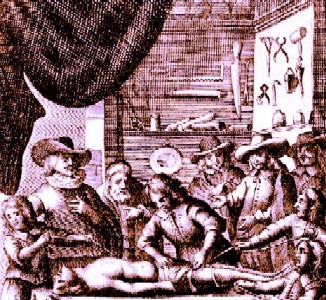
Dressing Thigh Fracture, from L'Arcenal de
Chirurgerie
by Johannes Scultetus, frontispiece (1653)
Other books from the time of the golden age of piracy echo these comments, showing how much of period fracture treatment was derived from Hippocrates. With regard to tightness, French surgeon Ambroise Paré suggests that the surgeon "see that it be not over-burdened, neyther too strait [tight] bound, otherwise it will be apt to inflammation."2 Sea surgeon John Woodall gives sterner warnings, explaining the 'over hard binding' "bringeth astonishment and hazard of a sudden Gangrene and death, it is a generall fault of divers young Surgeons, for many thinke they have never bound hard enough"3. He notes that while loose bandaging "is a fault", it could more easily be fixed.4
Military surgeon William Clowes gives the most extensive advice on this point. He explains that the surgeon's "manner of rolling must neither be too strait [tight], neither yet too loose; for by over loose binding the bones may be moved, and by too strait and over hard girding [encircling] doth hinder the distribution of nourishment into the part, and so lets the engendering or breeding of the soldering humour wherewith the bones are united and knit, which is said to be made of good nourishment inclined to grossness."5 (The concept of 'a soldering humor' is a most interesting way to explain the process of fracture healing!)
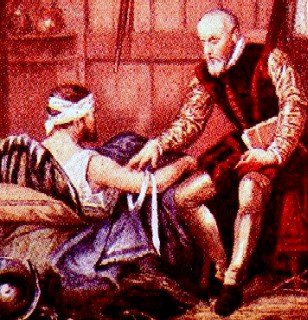
Artist: E. Hamman
Ambroise Paré Bandaging and Quizzing Patient
Like Hippocrates, several authors advised quizzing the patient to check bandage tightness. William Clowes explains that "the patient should have the feeling of the parts being properly secured, but not too tight, and in particular he should be able to say that they are firm about the wound."6 Ambroise Paré ordered "the Patient must be asked, Whether the member be bound up too strait? If he answer, No, (unlesse peradventure a little upon the fracture or luxation, for there it is fit it should bee more straitly [tightly] bound) then may you know that the binding is moderate."7 Sea surgeon John Woodall says that if the patient "complaine much of the paine, search the cause... [making sure] that it bee not too hard or too soft bound"8. In a similar manner, military and sea surgeon Richard Wiseman tells his surgical readers they "should often visit your Patient, to inform your self how the Bandage is."9
Although other authors do not mention swelling as a sign of a good fracture bandage, Richard Wiseman suggests, "A small and lax Tumour appearing at the extremity of the Member a day after, is a sign of good Bandage"10. While he regarded slight swelling as as good sign, Wiseman goes on to explain that "if the Swelling be so great and hard, then the Bandage is naught" and it needs to be loosened.11 Note that although swelling at the extremity of a bound member was considered a positive sign, swelling of the fractured are was considered dangerous and required treatment as we will soon see.
1 Hippocrates, Hiipocratic Writings, Translated and Edited by Francis Adams, p. 76; 2 Ambroise Paré, The Apologie and Treatise of Ambroise Paré, p. 172; 3 John Woodall, the surgions mate, p. 165; 4 Woodall, p. 165-6; 5 William Clowes, Selected Writings of William Clowes, p. 127-8; 6 Clowes, p. 127; 7 Paré, p. 170; 8 Woodall, p. 165; 9,10,11 Richard Wiseman, Of Wounds, Severall Chirurgicall Treatises, p. 464
Bandage Smoothness
Because fracture bandages were left on for several days and even weeks at a time, the manner of applying the bandages was important. A wrinkle could be a source of irritation that worked against proper healing. For example, Hippocrates notes that bandages "should be smoothly put on."1 John Woodall recommended that dressings be wrapped "about [the area as] smooth and close as you can, without wrinckles, lumps or seames, and that the ends may also foulded smoothe one over the other, wrapping it double and smooth"2. He also suggests that when a patient complains about their bandage, one cause of pain could be "wrinckles in the clouts applied"3.
1 Hippocrates, Hiipocratic Writings, Translated and Edited by Francis Adams, p. 76; 2 John Woodall, the surgions mate, p. 164-5; 3 Woodall, p. 162
Bandage Application Procedure
Surgical books in print during the period gave specific advice on how to apply bandages to the fractured part. Hippocrates had a great deal to say on the topic.
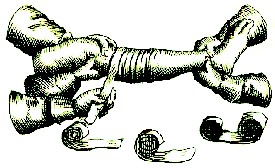
Fractured Leg Extended for Bandaging, from
L'Arcenal de
Chirurgerie
by Johannes Scultetus,
p. 106 (1653)
He begins recommending that the surgeon "apply the bandages while the limb is in a stretched position, making the first turns to the right or to the left, as may be most suitable"1. He feels that "bandaging and compression should always commence at the seat of the fracture, and everything else should be conducted on the same principle, so that the farther you proceed [away] from the fracture, the compression should always be the less."2 His reason for this is that it would drive the humors away from the fracture, permitting better healing.
William Clowes echos this in his procedure, "rolling [the bandage] directly upon the fracture, and so rolled it downwards, and in like manner ascending upwards again above the fracture."3 Richard Wiseman cites
Hippocrates in his book, explaining that the surgeon is "to begin upon the Fracture, and take three Turns there. Then rowl upward to the sound part [of the limb - closest to the body], and so a little higher, and there end this Rowler. It
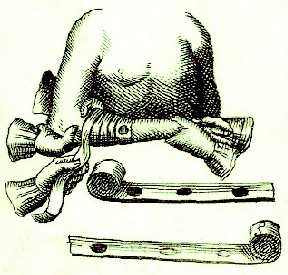
Dressing An Arm Fracture, from L'Arcenal de
Chirurgerie
by Johannes Scultetus, p. 68 (1653)
will keep the Fracture a little steady, until the other Bandage be made, and restrain the influx of Humours which might cause Inflammation."4
Wiseman gives very detailed explanations of how roller bandages are to be applied. He follows the first roller with a second, "rowled contrary to the first... This second Rowler must begin upon the Fracture, and after a Turn or two there, must be carried downwards, that so you may press the influx of Humours from the fractured part. And so having made three of four Turns downwards upon the sound part, you may rowl upwards again by the Fracture, and making Circumvolution [overlapping windings] upon the Fracture it self, pass upwards until you come to the end of the first Rowler."5
Wiseman says that the first two roller bandages do more to prevent inflammation than they do to hold the fracture in place. He is clearly concerned about keeping the bad humors away from the fracture. Next, he adds "Compresses of linen Cloth three or four times doubled, and of such length as to reach over the Fracture; but so narrow, as that five or six might be placed round about the Fracture, the distance of a finger one from another. These are so to be spred with a little Cerote [wax combined with lard], only to make them stick. They ...supply the defect of agglutinative [adhesive] Medicaments, and lessen the Pain, by hindering the Compression of the Bandage."6
With those in place, a third roller is used placing the middle of the bandage, "upon the Fracture, the one head being
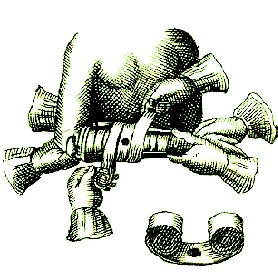
The Third, Double-Head Roller, from L'Arcenal de
Chirurgerie
by Johannes Scultetus, p. 68 (1653)
carried upwards, and the other downwards. And you are to take notice, that the Bandages are to be drawn more straight [wrapper tightly] upon the fractured Parts than elsewhere, than the said Parts being more weak, may be kept from Defluxions [flowing humors]."7
Sea surgeon John Moyle followed a similar procedure, starting with a bolster [piece of soft lint] 'smoothly applied'. Next he told the surgeon, "you must take a fine single Rouler, and fetch two or three turns about the fractured place, and fasten it."8 A roller bandage followed, "beginning [it] with two or three turns about the Fracture, then lead it upwards with the volves [turns of the bandage] pretty close [together], to hinder the deflux of humours, and fasten that Rouler at the Knee." Another, longer roller bandage was similarly started, running "contrary to the first, and so roul that downwards to the lower Joynt, with the foulds something more slack than the other, and then turning it [a]cross [itself], lead it up again to the Knee, and there fasten it with the other."9
John Woodall preferred not to use roller bandages as mentioned previously. He felt a freshly set fracture "shall be troubled much with lifting and rowling, it cannot but hinder unition, and procure some accidents offensive"10. Instead he laid a large clout or piece of fabric next to the fractured limb "above and below the fracture, so long that the ends of the splints I intend to use, may have a resting place on the clowt."11 He put another 'great cloth' under the splints "of a good bredth and length well armed with towe [soft lint]"12. These large pieces of cloth were tied with 'four of five' tapes - pieces of thin fabric. First one is gently tied. Then Woodall adds "so many as may compasse the fractured member, lying close [to each other], but with some small distance, that they touch not one another, then I tie the rest of the tapes, drawing them close, till the party sensibly feele them to bear in all places"13.
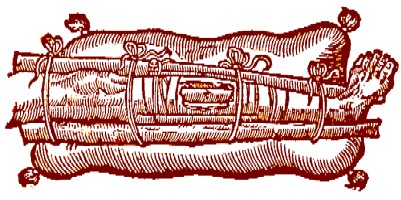
A Leg Fracture Dressed on a Pillow, from The Workes of That Famous
Chirurgeon Ambroise Parey, by Ambroise Paré, p. 374 (1649)
Before leaving this topic, a comment by Hippocrates is of interest. He explains that wen bandaging a fractured bone, "it should be laid upon some smooth and soft object so that it may not be distorted to the one side or the other, and that there may be no protrusion of the bones either forward or backward; for this purpose nothing is more convenient than a cushion, or something similar, either of linen or wool, and not hard; it is to be made hallow along its middle, and placed below the limb."14 Richard Wiseman concurs, explaining that the "hurt Part ought to lie soft: For that hard lying presses upon the bruised Bones and Flesh, and causes Pain and Inflammation."15
1 Hippocrates, Hiipocratic Writings, Translated and Edited by Francis Adams, p. 81; 2 Hippocrates, p. 77; 3 William Clowes, Selected Writings of William Clowes, p. 127; 4 Richard Wiseman, Of Wounds, Severall Chirurgicall Treatises, p. 467; 5 Wiseman,p. 467-8; 6,7 Wiseman,p. 468; 8 John Moyle, The Sea Chirurgeon, p. 120; 9 Moyle, p. 120-1; 10,11,12,13 John Woodall, the surgions mate, p. 161; 2 Hippocrates, p. 81; 15 Wiseman,p. 470
Bandage Openings for Complex Fractures
"If the Fracture is accompanied with a Wound, leave space between the Rollers, that you come to dress it every day, without unbinding the whole Member." (Matthias Gottfried Purmann, Churgia Curiosa, p. 213)
The previous discussion focuses on the bandages that hold the fracture in place. The dressings applied to the wound in a complex fracture were separate. Fractures with wounds required more time and attention than
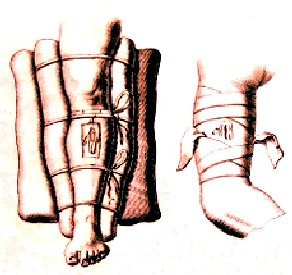
Bandages with Wound Openings From Alle De
Medinale en Chirurgicale, by Solingen Cornelius (1698)
simple fractures. Although Hippocrates told surgeons not to use splints on complex fractures while the wound was healing, he added, "if you do apply the splints, they should not be applied along the wound [leaving an opening], and they are to be put on in a loose manner"1.
Splints aside (we will deal with them on the following pages), fracture dressings were constructed so that the wound was left uncovered, allowing other dressings and plasters to be applied to the wound. That way they could be easily changed when needed.
Richard Wiseman notes that "whatever else you use [to dress the member], must have a large Hole cut in them for the Wound to be drest through."2 He explains in one of his fracture case studies that he created a "Compress more particularly for the Wound, purposing not to remove the two outermost heads of the main [fracture] Bandage, unless it were sometime to give a little breathing to the Member. But the middle I opened as often as I thought fit, to dress the Wound."3 Sea surgeon John Moyle likewise suggests leaving the wounded area clear of dressings.4
1 Hippocrates, Hiipocratic Writings, Translated and Edited by Francis Adams, p. 85; 2 Richard Wiseman, Of Wounds, Severall Chirurgicall Treatises, p. 423; 3 Richard Wiseman, p. 427; 4 John Moyle, The Sea Chirurgeon, p. 117
Bandage Application Procedure, Second Dressing
Hippocrates suggests keeping the first fracture dressings on for three days without changing them.1 Ambroise Paré recommends three or four days, "unlesse peradventure paine urge you to the contrary... for the Surgeon must with
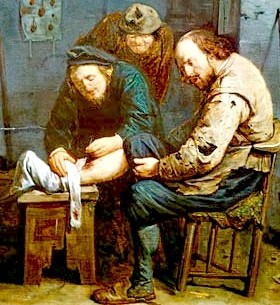
Artist: David Ryckaert
Re-Dressing a Leg Fracture, The Surgeon (1638)
all his art have a care to prohibite the happening of evill accidents and symptomes"2.
John Woodall stretches this out quite a bit, saying that "if there be no great cause, namely, through much paine or the like, you may well forbeare six daies, or tenne daies, provided that you see the legge bee straight and well laid in an even position or forme"3. In some places, Richard Wiseman follows Hippocrates' advice, re-dressing the fracture in three days.4 However, in his section on fracture treatment, Wiseman advises "if no Accident happen, you shall not unbind the Fracture until the seventh day"5. Wiseman's reasoning is that by that time the bandage will have become loose, probably as a result of the swelling of the fractured area being reduced. Sea surgeon John Atkins goes the furtherest out, suggesting that if the bone was properly set and pain minimized, the first dressing could be left on "without any Alteration for a Month; then the entire Slackness of the Bandage, and Itching of the Part, will call for an Opening"6.
Most surgeons recommended re-bandaging much sooner. On the third day, Hippocrates advises the surgeon to "make extension and adjust the fracture, and bind it up again"7. For fractured legs, he suggests, "Extension [of a fractured leg] should be made and the bones adjusted at every new bandaging; for, if properly treated, and if the swelling progress in a suitable manner, the bandaged limb will have become more slender and attenuated,
Hippocrates and the bones will be more mobile, and yield more readily to extensions."8
On the other hand, if the fracture is already correctly aligned, adjusting the bones again at this point would seem to draw out the healing process by damaging the body's natural healing process. Other period books do not suggest readjusting the fracture at successive dressings, perhaps with this in mind. Hippocrates does note that if "the bones are properly adjusted by the first dressings ...you may allow the arm to remain bandaged in the splints until after the lapse of more than twenty days."9
Hippocrates does make firm recommendations that second bandage of the fracture be made tighter. For arm fractures, he advises that when "the first bandaging was moderately applied, the second bandaging should be made somewhat tighter"10. For lower leg fractures, he suggests that "the bandaged part should be found reduced in swelling; and the new bandagings should be more tightly put on, and more pieces of cloth should be used"11. For fractures of the thigh bone, except "compression should be somewhat less than in the former."12
1 Hippocrates, Hiipocratic Writings, Translated and Edited by Francis Adams, p. 76; 2 Ambroise Paré, The Apologie and Treatise of Ambroise Paré, p. 170; 3 John Woodall, the surgions mate, p. 165; 4 For example, see the cased discussed by Wiseman, Of Wounds, Severall Chirurgicall Treatises, p. 427; 5 Wiseman,p. 464;6 John Atkins, The Navy Surgeon, p. 56; 7 Hippocrates, p. 76; 7 Hippocrates, p. 82; 9 Hippocrates, p. 77; 10 Hippocrates, p. 76; 11 Hippocrates, p. 82; 12 Hippocrates, p. 84
Bandage Application Procedure, Later Dressings
Most of the surgical writers do not go into great detail about providing later dressings. Hippocrates does say that "the part which had been bandaged should be found more slender and less swelled at each time, and on the seventh day the swelling should be quite gone"1. He again advises adjustment of the fracture again at this point since the swelling will not inhibit setting the bones.
1 Hippocrates, Hiipocratic Writings, Translated and Edited by Francis Adams, p. 77

